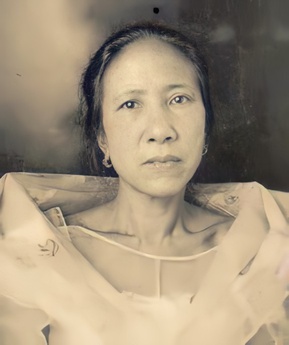Gregoria de Jesús facts for kids
Quick facts for kids
Gregoria de Jesús
|
|
|---|---|

Portrait of Gregoria de Jesús
|
|
| Vice President of the Tagalog Republic | |
| In office 24 August 1896 – 22 March 1897 |
|
| Preceded by | Post established |
| Succeeded by | Hilaria Aguinaldo |
| Personal details | |
| Born |
Gregoria de Jesús y Álvarez
9 May 1875 Caloocan, Manila, Captaincy General of the Philippines, Spanish Empire |
| Died | 15 March 1943 (aged 67) Manila, Philippine Commonwealth |
| Resting place | Manila North Cemetery |
| Political party | Katipunan |
| Spouses |
Julio Nakpil
(m. 1898) |
| Children | 7 (including Juan Nakpil) |
| Occupation | Housewife, Politician |
Gregoria de Jesús y Álvarez (born May 9, 1875 – died March 15, 1943) was a brave Filipino woman. People also knew her by her nickname, Oriang. She helped start and lead the women's group of the Katipunan. This was a secret society that fought for the freedom of the Philippines from Spain.
Oriang was also in charge of keeping the Katipunan's important papers and its official seal safe. She married Andrés Bonifacio, who was the main leader of the Katipunan. He was also the President of the Katagalugan Revolutionary Government. Gregoria de Jesús played a very important part in the Philippine Revolution. After Bonifacio passed away, she married Julio Nakpil, who was another general in the revolution. She had one son with Andrés Bonifacio and five children with Julio Nakpil.
Early Life and Education
Gregoria de Jesús was born in Caloocan, which was then part of the province of Manila. She came from a family that followed the Catholic faith. Her father, Nicolás de Jesús, was a carpenter. He later became a local leader called a gobernadorcillo.
As a young girl, Gregoria was a very good student. She even won a silver medal in a special test. This test was set up by the Governor-General and the local priest. When she was old enough for high school, her parents asked her to stay home. She helped take care of her younger sister and the family farm. This was because her older brothers had moved to Manila to continue their studies.
First Marriage and the Revolution
When Gregoria de Jesús was 18 years old, Andrés Bonifacio wanted to marry her. He told her parents about his wish. At first, her father was unsure about the marriage because of Bonifacio's beliefs. But Bonifacio kept trying to win her over. After about six months, Gregoria also fell in love with him. She told her father, and he finally agreed to their marriage.
Before they got married in March 1893, Gregoria joined the Katipunan. She chose the secret name Lakambini, which means "noblewoman" or "goddess" in Tagalog. They had two wedding ceremonies. First, they had a traditional church wedding at the Binondo Church. A week later, they had a special ceremony for the Katipunan members.
On the same evening, the women's group of the Katipunan was formed. Gregoria was chosen as its vice-president. She was also given the important job of keeping the group's secret documents safe. She promised to be loyal to the Katipunan's goals. When the Spanish police, called Guardia Civil, would suddenly search homes, Gregoria would quickly gather all the secret papers. She would then ride around town all night in a horse-drawn carriage called a calesa. She would only return home when it was safe.
A year later, Gregoria went back to her family's house. She gave birth to her only son, whom she named Andrés after her husband. Sadly, their baby son passed away a few months later from an illness.
In August 1896, the Katipunan's secrets were revealed. The Spanish forces quickly tried to stop the revolution. Many Filipinos were arrested and jailed. But Bonifacio and Gregoria went into hiding. The Katipuneros gathered and planned an attack. They were successful in their first fight. However, Spanish soldiers arrived, and many Katipuneros were killed or captured. There were also disagreements within the Katipunan itself. This made the group weaker.
In April 1897, Gregoria, Bonifacio, and his brother Procopio were captured by soldiers loyal to another leader. The Bonifacio brothers were later found guilty of certain charges. They were executed in May 1897.
Later Life and Legacy
After Andrés Bonifacio's death, Julio Nakpil took care of Gregoria. He was a commander in the Katipunan who was loyal to Bonifacio. Gregoria and Julio fell in love and got married in December 1898. Their wedding took place at Quiapo Church in Manila.
After the Philippine Revolution ended, Gregoria lived with Julio Nakpil and their six children. They lived in the house of Julio's sister, Petrona, and her husband, Dr. Ariston Bautista. The Bautistas did not have children of their own. They helped Gregoria raise and educate her children. Today, their house is known as the Bahay Nakpil-Bautista. It is a place dedicated to the history of the people who lived there.
Gregoria de Jesús passed away in 1943. This was during the time when Japan occupied the Philippines.
Site Link
- GREGORIA DE JESUS
- Gregoria de Jesus:Lakambini of the Katipunan
- National Heroes of the Philippines
- Solidarity Philippines Australia Network Retrieved 2006-12-28.

